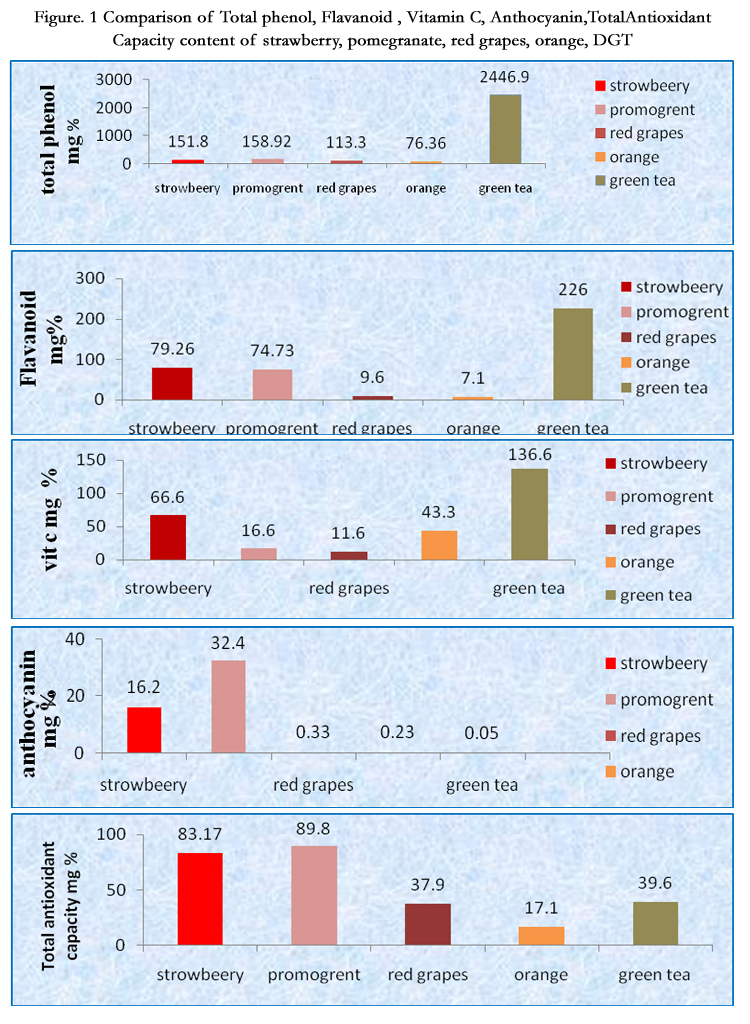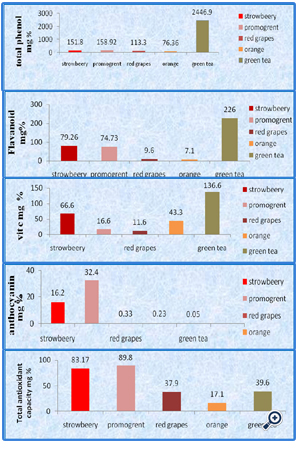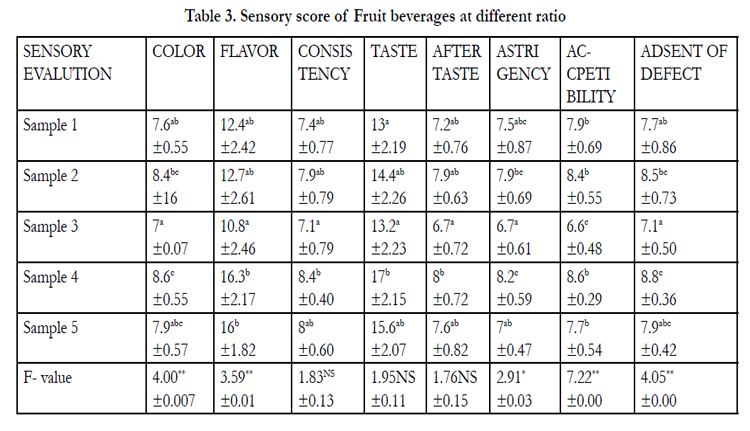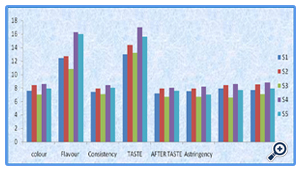Development and Evolution of Antioxidant Rich Fruit Beverage
Dharti P1 and Dhvanika P2*
1 Smt. K.P.Patel college of Home Science, Anand People’s Medicare Society ,Anand 388001, Gujarat, India.
2 Professor Smt. K.P.Patel college of Home Science, Anand People’s Medicare Society ,Anand 388001, Gujarat, India.
*Corresponding Author
Dhvanika Patel,
Smt. K.P.Patel college of Home Science,
Anand People’s Medicare Society,
Anand 388001, Gujrat, India.
Tel: +91-9979095023
E-mail: dhvanikunj@yahoo.com
Received: July 14, 2014; Accepted: October 07, 2014; Published: October 14, 2014
Citation: Dharti P and Dhvanika P. (2013), Development and Evolution
of Antioxidant Rich Fruit Beverage. Int J Food Sci Nutr Diet. 3(9),160-163. doi: dx.doi.org/10.19070/2326-3350-1400030
Copyright: Dhvanika P© 2013. This is an open-access article distributed under the terms of the Creative Commons Attribution License, which permits unrestricted use, distribution and reproduction in any medium, provided the original author and source are credited.
Abstract
The purpose of this study was to developed and analyzes Antioxidant rich fruit beverages to determine antioxidant concentrations. It may provide protection differently against oxidative stress because they are different in antioxidant capacity .Fruits are used commonly in form of fleshy or pulpy, juice. fruit juices and beverages are most effective against disease related to such as reduced level of oxidative stress , obesity, diabetes, atherosclerosis, high blood pressure, diabetes, osteoporosis, arthritis, some forms of cancer and even biological aging, chronic inflammation , Cardiovascular diseases. Antioxidant analysis such as Total Phenol, Flavanoids, Total antioxidant capacity,Vit C, Anthocyanins content in Pomegranate, strawberry, Red grapes, orange, Dried Green Tea. Fruit beverages were prepared at different ratio. Its’ content of antioxidants shows highly significant different with each other.
2.Introduction
3.Materials and Methods
3.1.Total Phenol by FolinCioculten method
3.2.Flavonoid by using Kosalecet et al method
3.3..Anthocyanin Pigment Content by AOAC Official Method
3.4.Total Antioxidant Capacity by Macue
3.5.Vitamin-C by using Roe and Kurther
3.6.Development Of Fruit Beverage
3.7.Standardization of Fruit Beverage
4.Result and Discussions
5.Conclusion
6.References
Keywords
Antioxidant, Fruit beverages, Fruit juice, Total phenol, Flavanoid.
Introduction
Fruits and vegetables are important sources of various vitamins, minerals, fibers, antioxidants, including ascorbic acid, carotenoids, and polyphenolic [1]. In common usage of fruits in the form of fleshy or pulpy, juicy, and it’s usually sweet, with fragrant aromatic flavors. [2] Citrus fruits are rich in bitter limondsand vitamins such as ascorbic acid, carotenoid, folates, polyphenols, and flavonoids. Fruit juice is very similar to that of the original fruit and 100% natural product. Fruit juices are free from chemical preservatives and other additives. Fruit juices contain nutrients, such as minerals, trace elements, vitamins and phytochemicals, micronutrients, potassium, calcium and magnesium, low in sodium and fat. [4] A large variety of vitamin enhanced waters (VEWs) on the market and some products advertise high concentrations of antioxidants and therefore high antioxidant capacity. There are also the four berry juices that are thought to be rich in polyphenols: These are noni, goji, mangosteen and acai. Other widely available polyphenol rich beverages are fruit and berry juices, i.e., blueberry, mango, pineapple, etc. Some of these juices have been analyzed for their antioxidant content [5].
Phenolic compounds as secondary metabolites are widely present in fruits and vegetables. A positive relationship between consumption of food with abundant phenolics and low incidence of degenerative diseases, including cancer, heart disease, inflammation, arthritis, brain dysfunction and cataracts. [6]. Flavonoids are diphenylpropanes that commonly occur in plants > 4000 flavonoids have been identified. Which are flavones, flavanones, anthocyanins, flavans, and proanthocyanidins .Anthocyanins are a group of flavonoids in fruits such as blackberry, blueberry, cranberry, raspberry, strawberry, and boysemberry (Rubus sp.), range from 200 to 4950 mg.kg-1 of fresh fruit. Consumption of 100 to 150 g(-1cup) of these fruits could easily result in an intake of 100 to 200 mg of anthocyanins [7].
Materials and Methods
In the present study was analysed antioxidant contain from DGT, Orange, Pomegranate, Red grapes, Strawberry and Developed Fruitbevrage .Four sample was prepaid in form of different ratio mixing with water and evolution by sensory score and selected sample analysis for their anti-oxidant concentration.
Sample Preparation is 10 gm of sample was mixed with 25ml 80% methanol, shaker for 2 hr, centrifuged at 8000rpm for 10min, collected supernatant. Standard of Gallic acid working solution (20-100μg) and made up volume 8ml with distilled water, 0.5ml of folincioculten (1:1) After 1 min add 1.5ml of sodium carbonate solutions, incubated for 2 hours at dark place and the reading 765nm on UV Spectrophotometer. For Sample, 0.1 ml of extracted sample and blank 8ml of D/W was taken and treated same as standard.
Extracted Total phenol sample 20ml evaporated in a water bath,add 2ml of 80% of methanol. Standard working solution of catchin (20-100μg),4mlD/w, 0.3ml Sodium nitrite, Incubated for 5minutes, 0.3ml of aluminumtrichloride, 2ml Sodium hydroxide, volume made by the Distil water and read at 510 nm on UV Spectrophotometer. For sample take 1ml and blank 1.5ml of D/W and treat same as standard.
The maximum Extracted sample Solution portion added should be 10 ml (1 part test portion, 4 parts buffer) so as not to exceed the buffer capacity .Sample Solution diluted (Mixed) with pH 1.0 buffer and same sample diluted with pH 4.5 buffer read at both 520 and 700 nm. The diluted sample portions are read versus a blank with distilled water.
Note:- Measure observance within 20–50 min of preparation. If the diluted test portion is excessively turbid, clarify by centrifuging or filtering before measurement.
Extracted Sample 0.5ml add 0.5ml Methanol, 3ml DPPH reagent, incubated at 37°C for 20 minutes, measured at517nm. The control sample was DPPH alone. Methanol was used as blank. For standardization Gallic acid use. Not DPPH Dye should be use after reach OD≤1
Sample preparation takes 2 gm sample, add 10 ml of 4% oxalic acid, centrifuge for 10-15 minutes. Collect the supernatant make up the volume 25 ml 4% oxalic acid and treat with a pinch of charcoal, Standard (Ascorbic acid) working 10 ml, blank 10 ml of 4% oxalic acid and sample 10ml titrate it against dye 2-6 dichloroindophenolblue, end point pink color.
Fruit beverage was developed from pure fruit juice and DGT (dried green tea) Extraction (2 GM of DGT in 100ml of water boiled for 15-20mins), after that Fruit beverages was evaluation of antioxidant content. For the preparation of fruit beverage all required ingredients were purchased from the local market of Anand.
The Fruit Beverages developed from DGT, Orange, Pomegranate,Red grapes, Strawberry, water were mixed in 5 different ratios as mentioned below. Sensory evaluation was done by 10 trained staff a member of the APMS campus Anand and one ratio (S4) was selected for further evolution. Sensory was done by composite scorecard for selection of fruit beverage. In sensory score card include colour, flavour, consistency, taste, after taste, astringency, over all acceptability, absent of defect.
Dehydrated Green Tea= DGT, Orange=O, Pomegranate juice = P, Red grapes = RG, Strawberry juice = S, Water=W.
S 1 : 10 ml GT +15 ml O+15ml P+15ml RG+15 ml S+30 ml W
S 2: 10 ml GT+10 ml O+20ml P+10ml RG+20 ml S+30 ml W
S 3: 10ml GT + 20ml O+10ml P + 20 ml RG+10ml S+ 30ml W
S 4: 20ml GT + 15ml O + 20ml P+15ml RG + 20ml S+ 10ml W
S 5: 20ml GT+20ml O+15ml P+20ml RG+15ml S + 10ml W
Result and Discussions
Picrate kit method was used to determine the cyanide levels in certain food samples in a step by step analytical procedure that depends mainly on colour changes in the sample being analysed; each cyanide level has his own colour code from which the cyanide level in a particular sample can be determined through the following procedures – the portable balance was placed on its U-shaped plastic mount so that it swings freely, pestle and mortar were used to grind roasted or hard samples into powder. The process involves comparing a derived colour to the colours in a cyanogenic kit colour chart to determine the level of cyanide in each sample. The flour was added to an empty spatula until balance was gained. Developed colour was compared with the colour on the cyanogenic kit colour chart which indicated the presence or abscence of cyanide and the concentration if present.
Total phenol, Flavanoid, Vitamin C, Anthocyanin, Total Antioxidant Capacity content of Strawberry, Pomegranate, Red grapes, Orange, DGT which were found highly significant difference (**P < 0.001) between comparisons to each other. (Table no 1.) where as Graphical show the DGT contain higher amount of Total phenol, Flavanoid, Vitamin C, and Pomegranate were contained higher amount of The Anthocyanin and The Total Antioxidant Capacity. (Fig 1) Fruit beverage was contained all antioxidants with good amount. (Table no 2). The sensory score for color, flavor, consistency, taste, aftertaste, Astringency, absence of defect, overall acceptability, was the highest score observed in Sample 4. (Table no. 3) and (Fig 2)
Table 1. Total phenol, Flavanoid , Vitamin C, Anthocyanin, Total Antioxidant Capacity content of Strawberry, Promogrent, Red grapes, Orange, DGT
Figure 1. Comparison of Total phenol, Flavanoid , Vitamin C, Anthocyanin,TotalAntioxidant Capacity content of strawberry,promogrent, red grapes, orange, DGT
Table 2. Total phenol, Flavanoid , Vitamin C, Anthocyanin, Total Antioxidant Capacity content of Fruit Beverage
Exactly 0.1 g of honey was weighed and dissolved with 100 ml of pure water.
Conclusion
Antioxidants have become a recent interest to health conscious individuals. As a result, beverages containing high concentrations of Antioxidants are becoming increasingly popular. This is due to the health benefits that accompany polyphenol consumption, derived from their antioxidant properties.Antioxidant has been found to inhibit reactive oxygen species formation and protect conducted. The fruit beverage contains large quantities of all the antioxidants which prevent human health problems.
References
- Amit P, Shailendra B (2011) “Pomegranate Juice Is Potentially Better Than Orange Juice in Improving Antioxidant Function in Elderly Subjects” Internatonal Journal of Biochemistry Research & Review 1: 14-23.
- Use of Fruits in the form downloaded from www.suu.edu/faculty/.../Fruit-Read.PDF.
- Patrizia R, Francesco V, Claudio G, Simona G, Antonella B, et al. (2005) “effect of blood orange juice intake on antioxidant bioavailability and on the different markers related to oxidative stress” journal of agricultural and food chemistry 53:941-947.
- FRUIT JUICE NUTRITION & HEALTH – SUMMARY. www.citrusbr.com/download/FRUIT_JUICE_NUTRITION_ShortPaper_a+a_final_Korrek.pdf
- Patrick E. D, Thomas M. C, Michael G. C Jr, Joe A. V (2010) Vitamin Enhanced Waters and Polyphenol Rich Beverages Analyzed for Antioxidant Capacity and Antioxidants/Calorie 2:1290-1296
- Wada L, Ou B. (2002) “Antioxidant activity and phenolic content of Oregon cranberries.” J. Agric Food Chem 50:3495-3500.
- Ronald L, Guohua C (2000) “ Antioxidant phytochemicals in fruits and vegetables: Diet and Health implications” Hortscience. 35(4).









